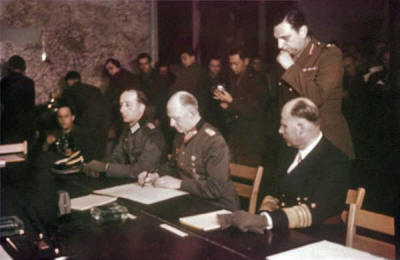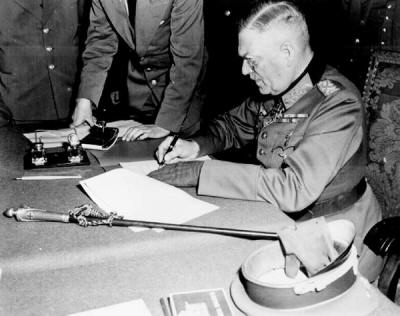|
If only for reasons of prestige, the Western Allies preferred that this would happen on the Western Front.
Secret talks with the Germans, which the British and Americans were holding at that time (i.e. in March 1945) in neutral Switzerland, code-named Operation Sunrise, were useful in that context, not only with an eye on a German surrender in Italy, which had actually led to the talks, but also in view of the coming general and supposedly unconditional German capitulation, of which intriguing details - such as the venue of the ceremony - might possibly be determined in advance and without input from the the Soviets.
There were many possibilities in this respect, because the Germans themselves kept approaching the Americans and the British in the hope of concluding a separate armistice with the Western powers or, if that would prove impossible, of steering as many Wehrmacht units as possible into American or British captivity by means of “individual” or “local” surrenders, i.e. surrenders of larger or smaller units of the German army in restricted areas of the front.
The Great War of 1914-1918 had ended with a clear and unequivocal armistice, namely in the form of an unconditional German surrender, which everybody knows went into effect on the eleventh hour of the eleventh day of the eleventh month of 1918.
The Second World War, on the other hand, was to grind to a halt, in Europe at least, amidst intrigue and confusion, so that even today there are many misconceptions regarding the time and place of the German capitulation. The Second World War was to end in the European theatre not with one, but with an entire string of German capitulations, with a veritable orgy of surrenders.
It started in Italy on April 29, 1945, with the capitulation of the combined German armies in southwestern Europe to the Allied forces led by Alexander, the British field marshal.
Signatories on the German side included SS General Karl Wolff, who had conducted the negotiations with American secret agents in Switzerland about sensitive issues such as the neutralization of the kind of Italian anti-fascists for whom there was no room in the American-British post-war plans for their country.
Stalin had expressed misgivings about the arrangement that was being worked out between the Western Allies and the Germans in Italy, but in the end he gave his blessing to this capitulation after all.
Many people in Great Britain firmly believe even today that the war against Germany ended with a German surrender in the headquarters of another British field marshal, namely Montgomery, on the Luneburg Heath in northern Germany.
Yet this ceremony took place on May 4, 1945, that is, at least five days before the guns finally fell silent in Europe, and this capitulation applied only to German troops that had hitherto been battling Montgomery’s British-Canadian 21st Army Group in the Netherlands and in Northwest Germany.
Just to be on the safe side, the Canadians actually accepted the capitulation of all German troops in Holland the next day, May 5, during a ceremony in the town of Wageningen, a town in the eastern Dutch province of Gelderland.[1]
In America and also in Western Europe the event on the Luneburg Heath is rightly viewed as a strictly local capitulation, even though it is recognized that it served as a kind of prelude to the definitive German capitulation and resulting ceasefire.
As far as the Americans, French, Belgians, and others are concerned, this definitive German surrender took place in the headquarters of General Eisenhower, the supreme commander of all Allied forces on the Western Front, in a shabby school building in the city of Reims on May 7, 1945, in the early morning.
But this armistice was to go into effect only on the next day, May 8, and only at 11:01 p.m. It is for this reason that even now, commemoration ceremonies in the United States and in Western Europe take place on May 8.
However, even the important event in Reims was not the final surrender ceremony.
With the permission of Hitler’s successor, Admiral Dönitz, German spokesmen had come knocking on Eisenhower’s door in order to try once again to conclude an armistice only with the Western Allies or, failing that, to try to rescue more Wehrmacht units from the clutches of the Soviets by means of local surrenders on the Western Front.
Eisenhower was personally no longer willing to consent to further local surrenders, let alone a general German capitulation to the Western Allies only.
But he appreciated the potential advantages that would accrue to the Western side if somehow the bulk of the Wehrmacht would end up in British-American rather than Soviet captivity.
And he also realized that this was a unique opportunity to induce the desperate Germans to sign in his headquarters the general and unconditional capitulation in the form of a document that would conform to inter-Allied agreements; this detail would obviously do much to enhance the prestige of the United States.
In Reims it thus came to a byzantine scenario.
First, from Paris an obscure Soviet liaison officer, Major General Ivan Susloparov, was brought over in order to save the appearance of the required Allied collegiality.
Second, while it was made clear to the Germans that there could be no question of a separate capitulation on the Western Front, a concession was made to them in the form of an agreement that the armistice would only go into effect after a delay of forty-five hours. This was done to accommodate the new German leaders’ desire to give as many Wehrmacht units as possible a last chance to surrender to the Americans or the British.
This interval gave the Germans the opportunity to transfer troops from the East, where heavy fighting continued unabatedly, to the West, where after the signing rituals in Luneburg and then Reims hardly any shots were being fired anymore.
The Germans, whose delegation was headed by General Jodl, signed the capitulation document at Eisenhower’s headquarters on May 7 at 2:41 a.m.; but as mentioned earlier, the guns were to fall silent only on May 8 at 11:01 p.m.
Local American commanders would cease to allow fleeing Germans to escape behind their lines only after the German capitulation actually went into effect.
It can be argued, then, that the deal concluded in the Champagne city did not constitute a totally unconditional capitulation.[2]
The document signed in Reims (image above) gave the Americans precisely what they wanted, namely, the prestige of a general German surrender on the Western Front in Eisenhower’s headquarters.
The Germans also achieved the best they could hope for, since their dream of a capitulation to the Western Allies alone appeared to be out of the question:
During this time, the fighting continued virtually only on the Eastern Front, and countless German soldiers took advantage of this opportunity to disappear behind the British-American lines.[3]
However, the text of the surrender in Reims did not conform entirely to the wording of a general German capitulation agreed upon previously by the Americans and the British as well as the Soviets. It was also questionable whether the representative of the USSR, Susloparov, was really qualified to co-sign the document.
Furthermore, it is understandable that the Soviets were far from pleased that the Germans were afforded the possibility to continue to battle the Red Army for almost two more days while on the Western Front the fighting had virtually come to an end.
The impression was thus created that what had been signed in Reims was in fact a German surrender on the Western Front only, an arrangement that violated the inter-Allied agreements.
In order to clear the air, it was decided to organize an ultimate capitulation ceremony, so that the German surrender in Reims retroactively revealed itself as a sort of prelude to the final surrender and/or as a purely military surrender, even though the Americans and the Western Europeans would continue to commemorate it as the true end to the war in Europe.[4]
General Keitel signs Germany’s unconditional surrender in Berlin (right)
It was in Berlin, in the headquarters of Marshal Zhukov, that the final and general, political as well as military, German capitulation was signed on May 8, 1945 or, put differently, that the German capitulation of the day before in Reims was properly ratified by all the Allies.
The signatories for Germany, acting on the instructions of Admiral Dönitz, were the generals Keitel, von Friedeburg (who had also been present in Reims) and Stumpf.
Since Zhukov had a lower military rank than Eisenhower, the latter had a perfect excuse for not attending the ceremony in the rubble of the German capital.
He sent his rather low-profile British deputy, Marshal Tedder, to sign, and this of course took some luster away from the ceremony in Berlin in favor of the one in Reims.[5]
As far as the Soviets and the majority of Eastern Europeans were concerned, the Second World War in Europe ended with the ceremony in Berlin on May 8, 1945, which resulted in the arms being laid down the next day, on May 9.
For the Americans, and for most Western Europeans, “the real thing” was and remains the surrender in Reims, signed on May 7 and effective on May 8. While the former always commemorate the end of the war on May 9, the latter invariably do so on May 8. (But the Dutch celebrate on May 5.)
That one of the greatest dramas of world history could have such a confusing and unworthy end in Europe was a consequence, as Gabriel Kolko writes, of the way in which the Americans and the British sought to achieve all sorts of big and small advantages for themselves - to the disadvantage of the Soviets - from the inevitable German capitulation.[6]
The First World War had ended de facto with the armistice of November 11, 1918, and de jure with the signing of the Treaty of Versailles on June 28, 1919.
The Second World War came to an end with an entire string of surrenders, but it never did come to a peace treaty à la versaillaise, at least not with respect to Germany. (Peace treaties were in due course concluded with Japan, Italy, and so on.)
The reason for this is that the victors - the Western Allies on the one side and the Soviets on the other side - were unable to come to an agreement about Germany’s fate.
Consequently, a few years after the war two German states emerged, which virtually precluded the possibility of a peace treaty reflecting an agreement acceptable to all parties involved.
And so a peace treaty with Germany, that is, a final settlement of all issues that remained unresolved after the war, such as the question of Germany’s eastern border, became feasible only when the reunification of the two Germanys became a realistic proposition, namely, after the fall of the Berlin Wall.
That made the “Two-plus-Four” negotiations of the summer and fall of 1990 possible, negotiations whereby on the one hand the two German states found ways to reunify Germany, and whereby on the other hand the four great victors of the Second World War - the United States, Great Britain, France, and the Soviet Union - imposed their conditions on the German reunification and cleared up the status of the newly reunited country, taking into account not only their own interests but also the interests of other concerned European states such as Poland.
The result of these negotiations was a convention that was signed in Moscow on September 12, 1990, and which, faute de mieux, can be viewed as the peace treaty that put an official end to the Second World War, at least with respect to Germany.[7]
Notes
|






